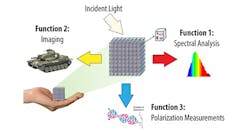The EXTREME Optics and Imaging (EXTREME) program from the Defense Advanced Research Projects Agency (DARPA; http://www.darpa.mil) aims to break from that well-worn paradigm that high-performance imagery devices are large, heavy, and complex (with dozens or more optical elements) by introducing engineered optical materials (EnMats) and associated design tools for creating innovative optical systems with improved performance, new functionality, and drastically reduced size and weight.
RELATED ARTICLE: DARPA's photonics projects—at the edge of possibility
A special notice was issued announcing the EXTREME Proposers Day on September 1, 2016, via webcast to familiarize potential proposers with the goals of the program and a Broad Agency Announcement solicitation is available on FedBizOpps at http://go.usa.gov/xDeT9.
"We've seen significant technical advances in recent years in the communities of optical system design, materials science and fabrication, and multiscale modeling and optimization," said Predrag Milojkovic, DARPA program manager. "EXTREME seeks to capitalize on this momentum by uniting these separate communities to revolutionize optics and imaging as we know it."
To achieve its objective, EXTREME is focused on developing new EnMats—both two-dimensional metasurfaces as well as 3D volumetric optics and holograms—that manipulate light in ways beyond classical rules of reflection and refraction. EXTREME also will address multiscale modeling to enable design and optimization of EnMats across vastly different scales, from nanometer to centimeter, for example.
The program aims to demonstrate an optical system with engineered surfaces where control of light propagation is decoupled from a specific geometric shape and can be tuned. EXTREME also seeks to demonstrate a volumetric optical element the size of a sugar cube or larger that can perform a multitude of functions simultaneously in visual and infrared (IR) bands, such as imaging, spectrum analysis, and polarization measurements, among others.
DARPA says that the project could introduce a new era in optics and imagers for national defense. EXTREME optical components would be lighter and smaller, enabling miniaturization of imaging systems for intelligence, surveillance, and reconnaissance (ISR) applications. The multifunctional nature of these devices could offer improvements in a wide variety of imaging systems by reducing size and weight without compromising performance for systems as diverse as night vision goggles, hyperspectral imagers, and IR search and track systems.
The project, says DARPA, will require formation of cross-cutting teams bringing together expertise from disparate communities and fields, including but not limited to engineered material design and fabrication, multiscale modeling/simulation/optimization, and optical system design. Details on the upcoming Proposers Day are available at http://go.usa.gov/xjugk.
SOURCE: DARPA; http://www.darpa.mil/news-events/2016-08-15

Gail Overton | Senior Editor (2004-2020)
Gail has more than 30 years of engineering, marketing, product management, and editorial experience in the photonics and optical communications industry. Before joining the staff at Laser Focus World in 2004, she held many product management and product marketing roles in the fiber-optics industry, most notably at Hughes (El Segundo, CA), GTE Labs (Waltham, MA), Corning (Corning, NY), Photon Kinetics (Beaverton, OR), and Newport Corporation (Irvine, CA). During her marketing career, Gail published articles in WDM Solutions and Sensors magazine and traveled internationally to conduct product and sales training. Gail received her BS degree in physics, with an emphasis in optics, from San Diego State University in San Diego, CA in May 1986.
